JUMP CUT
A
REVIEW OF CONTEMPORARY MEDIA




Buffy's worldview uses many Christian stories and symbols, although the show does not assume or endorse Christian theology. Crosses, such as this necklace that Buffy puts on when she becomes the Vampire Slayer, ward off vampires with varying degress of success.


Often portrayed as a Christ figure, Buffy comes back from the dead a number of times. Here (at the end of season 1) a powerful vampire bites her and ...

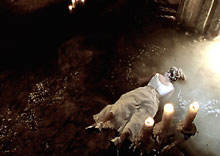
... leaves her to drown. Her friend Xander brings her back to life with CPR.




Buffy uses violence as a primary tool for ethical action. Here she fights vampires who have taken over a church.

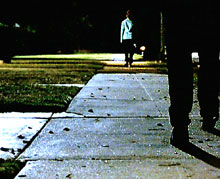
The show's premise: A pretty blonde girl is followed into a dark alley by a dangerous stranger, but ...

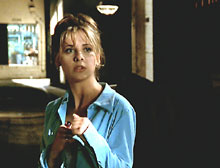
... instead of being mauled or murdered, she turns and violently defends herself. The show attacks cultural sterotypes and social forces that result in real violence against women.


Sunnydale is a dangerous place, where assault and murder occur regularly.


The show depicts violence as personal and intimate. Buffy usually fights in hand-to-hand struggles.


The epic moral struggle is not military or international. Its implications are global but it's fought locally, by geeks gathered in a library.


In season 4, Buffy's group fights Adam, a Frankestein figure that the U.S. military pieced together from demon parts.


A major theme in the series is community. Adam's horror contrasts with Buffy's united friends who fight him. Another time Sunnydale High's graduates unite to battle a demonic mayor.


Stereotypically feminine and physically powerful, wearing dresses and fighting demons, Buffy stakes traditional gender roles.

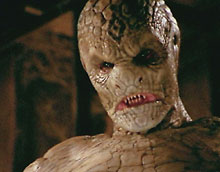
Buffy kills a demon that represents white male privilege and wealth. Fraternity boys serve it, feeding it young women so it will give them power and financial success.

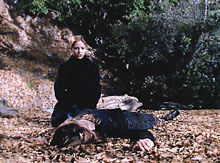
Buffy is devasted when she believes she has killed someone.


Faith, another vampire slayer, accidentally kills a human being. Her lack of remorse indicates her immorality.

What would Buffy do?
Feminist ethics and
epistemic violence
Introduction
As the violence in Iraq escalates while the television news reports that things are moving smoothly, I miss Buffy the Vampire Slayer. I am not interested, at the moment, in escapist drama or distracting comedy. I want the kind of substantial fictional world that certain shows and movies offer, worlds that make our own reality clearer and help us to think and speak more thoughtfully about real issues in our lives. Buffy the Vampire Slayer provided a space to think about violence from a feminist perspective, and we need that kind of thinking now.
Before the bracelet market was cornered by Lance Armstrong, there was a small trend of jewelry with the acronym “WWBD.” This merchandise is a play on a Christian slogan, “WWJD,” that reminds Christians to make ethical decisions by first asking “What Would Jesus Do?” The altered question, “What Would Buffy Do?” places Buffy the Vampire Slayer in the position of moral examplar. Buffy represents a violent female saviour who mirrors and counters the traditional image of Jesus as the gentle male saviour. The marked difference between the moral stances exemplified by Buffy and Jesus, particularly in relation to feminism and violence, suggests that the “WWBD” merchandise serves as a critical commentary on contemporary Christian ethics.
In this article, I analyze Buffy the Vampire Slayer as an alternative feminist paradigm of redemptive violence. In acknowledging the destructive force inherent in feminism, Buffy the Vampire Slayer provides access to feminist ethical discourse concerning violence that is pertinent to women’s lives and yet inaccessible in much popular U.S. Christianity. The fairly complex ethical stance towards violence presented in this series criticizes physical violence while calling for the destruction of simplistic and hurtful ways of seeing the world.
Choosing an appropriate moral exemplar:
a consumer kitsch critique
of Christian ethics
Given that “WWJD” merchandise is most popular among conservative Christians, the juxtaposed marketing of these two ethically-provocative acronyms presents an abbreviated theological conversation between two somewhat similar constituencies.[1] Both Buffy fans and conservative Christians engage in rituals (TV watching on Tuesday nights, church-going on Sunday mornings) and partake of mythologies (the Buffyverse, the Bible) in which evil is taken seriously and the language of the demonic is used to signify the strength of social ills and personal challenges. Both groups share a collection of symbols, such as the Cross, although their understanding and use of these symbols vary. And members of both groups allow themselves to be influenced by narratives that portray life as a fight between good and evil, their imaginations shaped by stories that valorize the struggle for good.
Scholars disagree about the relationship between Buffy the Vampire Slayer and Christianity. Some find the series to be deeply Christian, while others are adamant that the moral and symbolic framework of the show is not Christian. (Forster; King, “Brownskirts”; Sakal) I consider Buffy the Vampire Slayer to be culturally Christian, meaning that while the series does not claim to be Christian and does not consistently assume Christian theology, it is steeped in the stories, symbols, language, and professed values of Christianity.[2] Arising within a culture profoundly influenced by Christianity, it is little wonder that the epic battle between good and evil depicted in Buffy the Vampire Slayer should have a more or less Christian orientation. The Christian elements of the show appear strongly in the characterization of Buffy, who is often crafted as a Christ figure. At various times she chooses to befriend outcasts, gathers a band of devoted followers, wanders in the desert, is tempted by the possibilities of her own power, sacrifices herself to save the world, harrows hell, and is raised from the dead.
Despite these similarities, the kind of actions called to mind by the questions “What Would Jesus Do?” and “What Would Buffy Do?” are quite different.[3] It is difficult to imagine Jesus responding to a moral dilemma by thrusting a wooden stake through someone’s heart or snapping off a sarcastic remark about someone’s fashion sense. It is difficult to imagine Buffy choosing not to defend herself verbally, sitting silent while her sentence is passed. Or washing the feet of twelve men.
The reasons why Buffy and Jesus might call to mind different ethical responses are numerous (21st century Sunnydale vs. 1st century Jerusalem, etc.), especially to a Christian (fictional character vs. son of God). Yet if we abstract from their particular settings and situations, and abstain from evaluations regarding the historicity and divinity of Jesus, at least two significant differences in moral stances remain. The first is violence. The Bible presents Jesus as choosing not to engage in violent revolution, but rather allowing himself to be executed at the hands of the Roman authorities. While he did overturn the tables of the money changers and chase them out of the temple, there is no evidence that Jesus used physical violence as a means of change or a way to fight evil. Indeed, there is significant textual evidence that Jesus rejected physical violence. (See Yoder) In contrast, Buffy uses physical violence regularly as a primary tool of ethical action.
The second difference between their ethical stances is feminism. Many people find Christianity to be a deeply patriarchal religion that supports the oppression of women. (See Daly) Many others find Christianity to be liberating, affirming of women, and condemning of all forms of oppression.[4] There is textual evidence to support both positions, although much of contemporary American Christianity upholds stereotypical gender roles. Most Christian feminists acknowledge that Christianity is sexist at least on some levels, even if they find the overall truths of Christianity to be liberating.[5] In sharp contrast, Buffy the Vampire Slayer is an explicitly feminist show. Although the consistency and kind of feminism espoused by the show are often debated, the series self-consciously attacks certain cultural systems and assumptions, using wit, symbolism, and metaphor to fight sexism and patriarchy. I believe that the urge to make Buffy into a moral exemplar, and the criticism of Christian ethics implied in asking WWBD, is rooted in the series’ presentation of a feminist ethics of violence.
The production and consumption of WWBD merchandise suggests that Buffy’s ethical behavior, which clearly includes violence and advocates feminist principles, appeals to viewers as an alternative to the normative ethical claims presented by contemporary American Christianity. By replacing “Jesus” with “Buffy” in a Christian slogan, instead of generating some completely distinct affirmation of Buffy’s ethics, the WWBD merchandise proclaims Buffy a superior moral exemplar.
Violence in Buffy the Vampire Slayer
“Little Miss likes to fight”
Buffy the Vampire Slayer valorizes physical violence on both a practical level (how to survive in a dangerous world) and a religious level (how to save the world from evil). It is clear within the series that the world is infected by violence. Sunnydale is a dangerous place, where assault and murder are everyday realities. In this context, physical violence is presented as a necessity. Frequently it is the only way to survive the evening and/or save the world. Yet the show does not condone all physical violence; significant norms and restrictions are given regarding appropriate violence. Some of these norms are spoken clearly, while others are communicated more dramatically by being associated with either heroic or demonic characters. For the most part, Buffy’s behavior (at her best) is presented as exemplary, revealing the characteristics of appropriate use of violence.
First, Buffy’s violence tends to be personal and physically intimate. It is not the anonymous, antiseptic killing made possible by modern technology. The most significant fighting takes place between Buffy and demons or vampires that she knows; they know her name and she knows theirs.
A second, related, point is that Buffy’s violence is local. Buffy is involved in an epic battle upon which the fate of the entire world rests. Yet it remains a decidedly local conflict, not mediated by governmental policies and determined by structured hierarchy. It’s a small group of geeks in a library or a living room, learning the particular details about the demon of the week or the big bad of the season. While Buffy’s violence is spoken of as “war” at different times, it bears little resemblance to the realities of modern warfare in its organization, weaponry, strategies, or connection to government.
Third: While Buffy is repeatedly tempted to embrace the role of the slayer as the lone warrior, again and again she resists this temptation and fights alongside her friends. The theme of community runs deep in Buffy the Vampire Slayer. Buffy saves her friends’ lives and they save hers. Many enemies can only be overcome by the combined efforts of Buffy and the Scooby Gang. While the tradition of the Slayer would regard this as a weakness, Buffy’s community is her greatest strength.[6] In the series finale, Buffy shares her slayer-powers with women and girls everywhere.
The fourth characteristic of Buffy’s use of violence is perhaps the most remarked upon. She usually combines her physical violence with verbal assault: Buffy puns. She uses sarcasm, wry wit, and dark humor as both strategy and accompaniment to her fighting. Buffy the Vampire Slayer is known for its creative use of language. And Buffy’s constant pairing of witty wordplay with physical violence suggests an understanding of language as a remarkably powerful weapon.
A fifth trait of Buffy’s violence is that it takes place in decidedly feminine trappings. Against all considerations of practicality, Buffy chooses to fight demons while wearing high heels, tight skirts, elaborate updos, and nail polish. One of the ways the series combats sexist gender roles is by portraying Buffy as both stereotypically feminine and physically powerful. While this acceptance of stereotypical markers of femininity is problematic in its own right, within the ironic context of the show it undoes its own assertion. Buffy’s feminine fight-wear makes the point that one does not cease to be female or feminine when one is strong, aggressive, and even violent, because stereotypical gender markers are inadequate to the complexities of identity. It isn’t just that Buffy can’t be contained in gender stereotypes; none of us can.
The sixth characteristic of how Buffy uses violence relates directly to ethics. Buffy’s violence is usually directed toward evil beings that appear in pure and monstrous form. Demons are neither humans nor animals. Others have noted that demons in Buffy the Vampire Slayer are metaphors, societal ills that are symbolically manifest in monstrous form. (Such as Wilcox, “Who.”)
There is a clear prohibition against killing humans, as humans are never purely evil. Buffy explicitly mentions a “rule that slayers don’t kill people.”(3.11, “Gingerbread”) In situations where humans become monstrous against their will, such as werewolves, moral statements prohibiting life-ending violence are voiced explicitly and repeatedly by Buffy, Willow, and Giles. (2.15, “Phases,” 2.6, “Halloween”) Twice Buffy mistakenly believes she has killed a human and is devastated. (2.11, “Ted,” 6.16. “Dead Things”) When Faith, another slayer who represents the shadow-side of Buffy, accidentally kills a human being, it is regarded by Buffy and the Scooby Gang as a terrible, monumental occurrence.[7]Faith defends her actions by saying the victim was a likely a bad person, and that her other actions had saved countless lives, Buffy responds that it is not their “job to judge people.”(3.15, “Consequences”) Buffy frequently beats humans up while defending herself and others, but she does not kill them.
Thus far, Buffy the Vampire Slayer seems to present a fairly tidy morality: kill demons, not humans.[8] However, this clear distinction serves as a backdrop for the explorations of moral ambiguity that are at the heart of the series. In Season One we meet Angel, a vampire with a soul. Buffy lets him live and falls in love with him. At the end of Season Two, Buffy kills Angel, whose soul had just been restored, in order to save the world. In Season Four she refrains from killing Spike because, even as a soulless vampire, he presented no threat to the world since he had a chip implanted in his brain that prevented him from harming humans.[9] In Season Five, Giles both breaks the rule that humans must not be killed and upholds it, killing the human Ben in order to prevent the destructive god Glory from returning. Intimately closing his hand over Ben’s mouth and nose, he smothers him while explaining that for the good of the world he must be killed but Buffy cannot do it, because she is “a hero.”(5.22. “The Gift”)
Throughout the series, Buffy engages in difficult ethical choices of deep moral ambiguity. The ethics of violence presented is not completely clear-cut, but it is fairly consistent and sturdy. Violence is necessary in a violent world. In relation to pure evil that poses a continuing threat to humanity, deadly violence is appropriate. In regards to morally ambiguous beings, including all humans, violence is used with restraint, and deadly violence is only used in extreme cases.
Two other important aspects of how violence is portrayed in Buffy the Vampire Slayer need to be mentioned. First, committing unethical physical violence, such as killing a human, is presented as dangerous to one’s own soul. In Season Three, after Faith kills a human, different characters on the show talk about how hard this must be for her, imagining feelings of guilt and grief. They are confused and troubled that Faith does not exhibit these expected emotions. Angel has a different view of the situation. He says, “She’s taken a life. She’s got a taste for it now.” (3.15, “Consequences”)
Finally, violence in Buffy the Vampire Slayer is frequently linked to sex. The series does not eroticize violence as sexy. Rather, it recognizes that sexual relationships take place within a violent world and are thereby infected with violence. Likewise, violence takes place within a sexist world, and is therefore shaped by sexual politics that oppress and victimize women. In the first five seasons, characters in the series who enjoy violence as sexual, in the sado-masochistic sense of giving and receiving pain, are morally deficient beings. The primary example is vampires, who frequently exhibit, refer to, or invoke images of sado-masochistic activity. Faith also finds violence sexy, using similar words, motions, and sounds to describe sex and slaying a vampire. (3.14, “Bad Girls”) When Xander comes to talk with her after she first kills a human, Faith acts as if he’s there for sex, maneuvers him into a sexual position, and nearly kills him. (3.15, “Consequences”)
Later, after Buffy is brought back from heaven and must try to resume her life in Season Six, she engages in a violent sexual relationship with Spike, as an attempt to feel, however briefly, alive. While this relationship is developed at length and presented as somewhat sympathetic, in the end it is presented as a shameful, self-destructive relationship from which Buffy must walk away because Spike has no soul and Buffy is just using him. The violent sex is not identified as the major reason this relationship is wrong. Yet the ultimately negative evaluation of their sexual relationship is consistent with the presentation of violent sex throughout the series: it is not ideal, or even appropriate, sexual behavior. Sexualized violence is the domain of the vampires, a temptation to Buffy that is indulged by her shadow-side, Faith, and by herself when she is soul-sick.
(Continued: Violence in feminism)